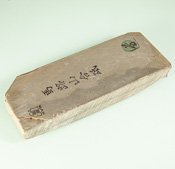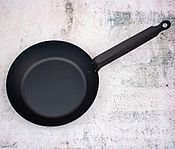Koutetsu
Koutetsu

I had my new knife. Now I wanted to give it a name. The shape eminded me of something...what was it?
The Koutetsu
Japan's first ironclad ship. Her name means, literally, "Ironclad." The Koutetsu had a very unusual bow. It looks like my knife. And the Koutetsu was the first in her class, and she used a pioneering, "cutting-edge" design - just like my knife.
The Koutetsu was formidable - just like my knife. And the Koutetsu was ironclad - somewhat like my knife. My knife is actually steel clad with steel. Inside I put SG-2 (R2) stainless powder steel. Outside, I have clad it with stainless steel sides. This 2-steel combination is easier to sharpen, and it keeps its edge better, and it resists damage better.

In my kitchen I was using a gyuto knife. It was a beautiful knife. But it was a little too curved for my liking. Didn't make enough contact with the food. So I switched to a straight-edged nakiri. Better for chopping vegetables. But when I was cutting meat, then I wanted to go back to my gyuto. Hmm, I thought. Somebody should make a new type of knife, one that falls between a gyuto and a nakiri. And then, as I am a knife maker, I thought that I should make it. So I did.
I gave it a slightly curved edge. Too-straight produces too much friction. Too-curved reduces contact with the food. This slight curve is my attempt at a happy medium.
I also gave it a sharp point. This is very nice for scoring vegetables, or squid, or chicken.
The spine of the knife has a very high mirror-polish. This maximizes friction between your fingers and the blade, for better control, comfort, and safety.
The sides of the knife have a rough finish, to minimize friction between the food and the blade. This is especially noticeable with foods that have a high water content. My knife's rough sides break up the water's surface tension, allowing the blade to slide through more easily.

Diese wunderschönen Messer wurden von Shibata Takayuki hergestellt und entworfen. Die sehr dünn ausgeschmiedeten und geschliffenen Klingen sind rasiermesserscharf und gleiten dank dem sehr flachen V-Schliff mühelos durch knackigstes Gemüse. Dank der rostfreien Aussenhaut und dem SG-2 (R2) Pulverstahl ist das Messer absolut rostbeständig. Für den Griff wird ausgesuchtes Rosenholz verwendet in 8-eckiger Ausführung und ist somit für Links und Rechtshänder geeignet. Die Zwinge besteht aus schwarzem Pakkaholz. Der Übergang von der Klinge zum Griff ist versiegelt damit nichts in den Griff eindringen kann. Alle Klingenkanten sind sauber auspoliert, das Messer ist perfekt verarbeitet. Die Messer haben einen rasiermesser scharfen Werksschliff und werden in einer schwarzen Karton Geschenkverpackung ausgeliefert.
Besuch bei Shibata Takayuki im Mai 2016



 für Brot
für Brot für das Meiste
für das Meiste für Fisch/Sushi
für Fisch/Sushi für Fleisch
für Fleisch für Gemüse
für Gemüse für Rüstarbeiten
für Rüstarbeiten Aoki Byakko
Aoki Byakko Aoki Tokujou
Aoki Tokujou Aoki V-Gold
Aoki V-Gold Aoki with Carving
Aoki with Carving Ashi Hamono Ginga
Ashi Hamono Ginga Dao Vua Classic V2 Kurouchi
Dao Vua Classic V2 Kurouchi Dao Vua Leaf Spring Kurouchi
Dao Vua Leaf Spring Kurouchi Dao Vua Nashiji
Dao Vua Nashiji Dao Vua V3 Tsuchime
Dao Vua V3 Tsuchime Dao Vua Western Kurouchi
Dao Vua Western Kurouchi Fujiwara Teruyasu Denka
Fujiwara Teruyasu Denka Fujiwara Teruyasu Kurouchi
Fujiwara Teruyasu Kurouchi Fujiwara Teruyasu Maboroshi
Fujiwara Teruyasu Maboroshi Fujiwara Teruyasu Nashiji
Fujiwara Teruyasu Nashiji Goko Hamono Kurouchi
Goko Hamono Kurouchi Goko Hamono Nashiji
Goko Hamono Nashiji Guangzhou VG10 black Tsuchime
Guangzhou VG10 black Tsuchime HADO SG2 Shiosai Urushi
HADO SG2 Shiosai Urushi HADO Sumi
HADO Sumi Hatsukokoro Ginsou Silver3
Hatsukokoro Ginsou Silver3 Hatsukokoro Hayabusa AS
Hatsukokoro Hayabusa AS Hatsukokoro Hayabusa HAP40
Hatsukokoro Hayabusa HAP40 Hatsukokoro Hayabusa SG2
Hatsukokoro Hayabusa SG2 Hatsukokoro Hayabusa Silver3
Hatsukokoro Hayabusa Silver3 Hatsukokoro Hayabusa VG-5
Hatsukokoro Hayabusa VG-5 Hatsukokoro Hikari SLD
Hatsukokoro Hikari SLD Hatsukokoro Kokugei Blue1
Hatsukokoro Kokugei Blue1 Hatsukokoro Komorebi Blue2
Hatsukokoro Komorebi Blue2 Hatsukokoro Kurokaze White2
Hatsukokoro Kurokaze White2 Hatsukokoro Kurokuma Blue2
Hatsukokoro Kurokuma Blue2 Hatsukokoro Kuronami Blue2
Hatsukokoro Kuronami Blue2 Hatsukokoro Kurosagi AS Kurouchi
Hatsukokoro Kurosagi AS Kurouchi Hatsukokoro Shirahama
Hatsukokoro Shirahama Hatsukokoro Sumi Blue2 Kurouchi
Hatsukokoro Sumi Blue2 Kurouchi Hatsukokoro VG10 Tsuchime
Hatsukokoro VG10 Tsuchime Hatsukokoro Yoake Kurouchi
Hatsukokoro Yoake Kurouchi Hayashi Aogami Super
Hayashi Aogami Super Hideo Kitaoka Black
Hideo Kitaoka Black Hinokuni Shirogami 1 Kurouchi
Hinokuni Shirogami 1 Kurouchi Hiroshi Kato AS Kurouchi
Hiroshi Kato AS Kurouchi Hiroshi Kato AS Nashiji
Hiroshi Kato AS Nashiji Isamitsu Shirogami 1 Kurouchi
Isamitsu Shirogami 1 Kurouchi Kanetsugu Miyabi Isshin
Kanetsugu Miyabi Isshin Kanetsugu Pro J
Kanetsugu Pro J Kanetsugu Pro M
Kanetsugu Pro M Kanetsugu Pro S
Kanetsugu Pro S Kanetsugu SHIUN VG10 Tsuchime
Kanetsugu SHIUN VG10 Tsuchime Kanetsune KC-140 MEISHO
Kanetsune KC-140 MEISHO Kei Kobayashi R2
Kei Kobayashi R2 Kisuke Aogami 1
Kisuke Aogami 1 Kohsey Aogami Super Tsuchime
Kohsey Aogami Super Tsuchime Kohsey HAP40 Tsuchime
Kohsey HAP40 Tsuchime Konosuke GS
Konosuke GS Konosuke GS+
Konosuke GS+ Konosuke Mirror
Konosuke Mirror Koutetsu
Koutetsu Kuwabara Kurouchi
Kuwabara Kurouchi Kyohei Kurouchi Aogami 2
Kyohei Kurouchi Aogami 2 Makoto Kurosaki SG2
Makoto Kurosaki SG2 Masakage Koishi
Masakage Koishi Masakage Yuki
Masakage Yuki Masakage Zero
Masakage Zero Masashi Kobo AO1 Tsuchi Kuro
Masashi Kobo AO1 Tsuchi Kuro Masashi Kobo SLD polished
Masashi Kobo SLD polished Masashi Kobo VS1 Nashiji
Masashi Kobo VS1 Nashiji Masashi Kobo VS1 Tsuchime
Masashi Kobo VS1 Tsuchime Masutani Tsuchime/Nashiji VG-1
Masutani Tsuchime/Nashiji VG-1 Mazaki Shirogami Kuro Nashiji
Mazaki Shirogami Kuro Nashiji Mcusta Beyond Aogami Super
Mcusta Beyond Aogami Super Mcusta Zanmai Revolution SPG2
Mcusta Zanmai Revolution SPG2 Miki Hamono Nashiji
Miki Hamono Nashiji Miki Hamono Tsuchime
Miki Hamono Tsuchime Minamoto Izumimasa Exklusiv
Minamoto Izumimasa Exklusiv Moritaka Aogami 2
Moritaka Aogami 2 Moritaka Aogami Supreme
Moritaka Aogami Supreme Muneishi AO2 Kurouchi
Muneishi AO2 Kurouchi Myojin Riki Seisakusho
Myojin Riki Seisakusho Nigara AS Tsuchime
Nigara AS Tsuchime Nigara R2 Tsuchime
Nigara R2 Tsuchime Nigara R2 Tsuchime Kurouchi
Nigara R2 Tsuchime Kurouchi Nishida Shirogami Kurouchi
Nishida Shirogami Kurouchi Nishida Shirogami Mirror
Nishida Shirogami Mirror Otsuka Hamono
Otsuka Hamono RyuSen Blazen
RyuSen Blazen Ryusen Super Gold
Ryusen Super Gold Sabol Brothers
Sabol Brothers Shibamasa VG-5 Santoku
Shibamasa VG-5 Santoku Shiro Kamo Aogami 2 Ebony
Shiro Kamo Aogami 2 Ebony Shiro Kamo Aogami 2 Kurouchi
Shiro Kamo Aogami 2 Kurouchi Shiro Kamo Aogami 2 Magnolia
Shiro Kamo Aogami 2 Magnolia Shiro Kamo AS Kurouchi
Shiro Kamo AS Kurouchi Shiro Kamo Limited Edition
Shiro Kamo Limited Edition Shiro Kamo Orca AS
Shiro Kamo Orca AS Shiro Kamo Orca R2
Shiro Kamo Orca R2 Shiro Kamo R2
Shiro Kamo R2 Shiro Kamo Spezial AO2
Shiro Kamo Spezial AO2 Shu Matsubara AO2 Nashiji
Shu Matsubara AO2 Nashiji Shu Matsubara AO2 Tsuchime
Shu Matsubara AO2 Tsuchime Shu Matsubara Ginsan3 Nashiji
Shu Matsubara Ginsan3 Nashiji Suncraft Elegancia SG2
Suncraft Elegancia SG2 Suncraft Entrée
Suncraft Entrée Tadafusa
Tadafusa Takamura Migaki R2
Takamura Migaki R2 Takeo Murata
Takeo Murata Tanaka Nashiji Silver3
Tanaka Nashiji Silver3 Tanaka Shigeki Aogami 2 Black
Tanaka Shigeki Aogami 2 Black Tanaka Shigeki VG10 Nashiji
Tanaka Shigeki VG10 Nashiji Tetsujin Hamono AO2/Metal Flow
Tetsujin Hamono AO2/Metal Flow Tokaji Shirogami Black Magnolia
Tokaji Shirogami Black Magnolia Tsukasa Ajikataya Nashiji
Tsukasa Ajikataya Nashiji Tsukasa Tsuchime Kurouchi
Tsukasa Tsuchime Kurouchi Tsunehisa AS Tsuchime
Tsunehisa AS Tsuchime Tsunehisa Ginsan Nashiji
Tsunehisa Ginsan Nashiji Tsunehisa Shirogami Tsuchime
Tsunehisa Shirogami Tsuchime Tsunehisa SLD Migaki
Tsunehisa SLD Migaki Tsunehisa SLD Washiji
Tsunehisa SLD Washiji Wakui Aogami Nashiji Kurouchi
Wakui Aogami Nashiji Kurouchi Wakui Shirogami Nashiji
Wakui Shirogami Nashiji Yamamoto AO Kurouchi
Yamamoto AO Kurouchi Yoshikane Shirogami Nashiji
Yoshikane Shirogami Nashiji Yoshikane Shirogami Tsuchime
Yoshikane Shirogami Tsuchime Yoshikane SKD11 Nashiji
Yoshikane SKD11 Nashiji Yoshikazu Tanaka Kurouchi
Yoshikazu Tanaka Kurouchi Yoshimi Kato SG2 Hyo
Yoshimi Kato SG2 Hyo Yoshimi Kato SG2 Minamo
Yoshimi Kato SG2 Minamo Yoshimitsu Shirogami 1
Yoshimitsu Shirogami 1 Yu Kurosaki AS Kurouchi
Yu Kurosaki AS Kurouchi Yu Kurosaki Gekko
Yu Kurosaki Gekko Yu Kurosaki R2
Yu Kurosaki R2 Yu Kurosaki R2 Fujin
Yu Kurosaki R2 Fujin Yu Kurosaki Raijin Cobalt
Yu Kurosaki Raijin Cobalt Yu Kurosaki Senko R2
Yu Kurosaki Senko R2 Zakuri
Zakuri Aoki Suogo Yamatsuka
Aoki Suogo Yamatsuka Aoki Uzushio
Aoki Uzushio Azai Custom Pulverstahl
Azai Custom Pulverstahl Azai VG10 (Wa) etched
Azai VG10 (Wa) etched Azai VG10 Black
Azai VG10 Black Azai VG10 Wa Mirror Damascus
Azai VG10 Wa Mirror Damascus Copper 21
Copper 21 Damaskus 17 Hammered
Damaskus 17 Hammered Damaskus 45 Hammered
Damaskus 45 Hammered Echizen Japan
Echizen Japan Guangzhou VG10 Damascus black
Guangzhou VG10 Damascus black Hashimoto Shoichi Coreless
Hashimoto Shoichi Coreless Hatsukokoro Ginga ATS-34 Damascus
Hatsukokoro Ginga ATS-34 Damascus Hatsukokoro Ginyo Silver 3
Hatsukokoro Ginyo Silver 3 Hatsukokoro Hikari SLD Damascus
Hatsukokoro Hikari SLD Damascus Hatsukokoro Inazuma AS
Hatsukokoro Inazuma AS Hatsukokoro Komorebi Blue 1
Hatsukokoro Komorebi Blue 1 Hatsukokoro Kumokage AO2
Hatsukokoro Kumokage AO2 Hatsukokoro Ryuhyo SG2
Hatsukokoro Ryuhyo SG2 Hatsukokoro Ryusui Aogami 2 Nashiji
Hatsukokoro Ryusui Aogami 2 Nashiji Hatsukokoro Saihyo SG2
Hatsukokoro Saihyo SG2 Hatsukokoro Shinkiro AS
Hatsukokoro Shinkiro AS Hatsukokoro VG10 Dama Tsuchime
Hatsukokoro VG10 Dama Tsuchime Hayashi Aogami 2 Damascus
Hayashi Aogami 2 Damascus Hideo Kitaoka
Hideo Kitaoka Hiroshi Kato VG10 Black
Hiroshi Kato VG10 Black Kanetsugu Saiun Damascus
Kanetsugu Saiun Damascus Kanetsugu Zuiun
Kanetsugu Zuiun Kanetsune KC-100
Kanetsune KC-100 Katayama VG10 Damascus
Katayama VG10 Damascus Kei Kobayashi R2 Damascus
Kei Kobayashi R2 Damascus Kiya Hamono SG2 Damascus
Kiya Hamono SG2 Damascus Kiya Hamono VG10 Damascus
Kiya Hamono VG10 Damascus Konosuke Keiai NT
Konosuke Keiai NT Masakage Kiri
Masakage Kiri Masakage Kumo
Masakage Kumo Masakage Shimo
Masakage Shimo Masashi Kobo Blackclouds
Masashi Kobo Blackclouds Masashi Kobo polished
Masashi Kobo polished Masuda Yoshihide Blue 1 Damascus
Masuda Yoshihide Blue 1 Damascus Masutani Damascus
Masutani Damascus Mcusta Zanmai Classic Pro
Mcusta Zanmai Classic Pro Mcusta Zanmai Ripple
Mcusta Zanmai Ripple Mcusta Zanmai Ultimate Aranami
Mcusta Zanmai Ultimate Aranami Mcusta Zanmai Ultimate Unkai
Mcusta Zanmai Ultimate Unkai Minamoto Izumimasa Damascus
Minamoto Izumimasa Damascus Moritaka AS Damascus
Moritaka AS Damascus Mr. Kazuo Nomura
Mr. Kazuo Nomura Mr. Tani Yuzo
Mr. Tani Yuzo Nakagawa Satoshi Blue1
Nakagawa Satoshi Blue1 Nigara Blue 2 Anmon/Kurozome
Nigara Blue 2 Anmon/Kurozome Nigara R2 Anmon Damascus
Nigara R2 Anmon Damascus Nigara VG-XEOS Tsuchime Damascus
Nigara VG-XEOS Tsuchime Damascus Nigara VG10 Tsuchime Damascus
Nigara VG10 Tsuchime Damascus OEM Damascus 33-Lagen
OEM Damascus 33-Lagen Ono Knife Suzukaze SG2 Damascus
Ono Knife Suzukaze SG2 Damascus RyuSen Bontenunryu
RyuSen Bontenunryu RyuSen DP forged Damascus
RyuSen DP forged Damascus Sakon
Sakon Senzo Black Damascus
Senzo Black Damascus Senzo Tsuchime
Senzo Tsuchime Senzo Tsuchime Universal
Senzo Tsuchime Universal Shibamasa Damascus VG-5 Santoku
Shibamasa Damascus VG-5 Santoku Shiki from Hiro Limited Edition
Shiki from Hiro Limited Edition Shiro Kamo Aogami 2 Damascus
Shiro Kamo Aogami 2 Damascus Shiro Kamo AS Damascus
Shiro Kamo AS Damascus Shiro Kamo Orca R2 Damascus
Shiro Kamo Orca R2 Damascus Shiro Kamo R2 Damascus
Shiro Kamo R2 Damascus Shiro Kamo Shirogami
Shiro Kamo Shirogami Shiro Kamo VG10
Shiro Kamo VG10 Shu Matsubara Ginsan3 Damascus
Shu Matsubara Ginsan3 Damascus Shu Matsubara ZDP-189 Damascus
Shu Matsubara ZDP-189 Damascus Takeshi Saji
Takeshi Saji Takeshi Saji R2
Takeshi Saji R2 Takeshi Saji Rainbow
Takeshi Saji Rainbow Takeshi Saji VG10 Gold
Takeshi Saji VG10 Gold Takumi Ikeda AS Damascus
Takumi Ikeda AS Damascus Tanaka Shigeki AO2 Damascus
Tanaka Shigeki AO2 Damascus Tanaka Shigeki R2 Damascus
Tanaka Shigeki R2 Damascus Tanaka Shigeki VG10 Damascus
Tanaka Shigeki VG10 Damascus Tokaji Aogami 1 Damascus
Tokaji Aogami 1 Damascus Tsukasa Hinoura
Tsukasa Hinoura Tsunehisa 440C Dama Washiji
Tsunehisa 440C Dama Washiji Tsunehisa AUS10 Nami
Tsunehisa AUS10 Nami Tsunehisa AUS10 Nawame Damascus
Tsunehisa AUS10 Nawame Damascus Tsunehisa AUS10 Tsuchi Dama
Tsunehisa AUS10 Tsuchi Dama Tsunehisa Geppaku Tsuchi Dama
Tsunehisa Geppaku Tsuchi Dama Tsunehisa SLD Damascus
Tsunehisa SLD Damascus Tsunehisa ZA-18 Enjyu
Tsunehisa ZA-18 Enjyu Tsutomu Kajiwara
Tsutomu Kajiwara Yamamoto AS Tsuchi Damascus
Yamamoto AS Tsuchi Damascus Yauji Suminagashi
Yauji Suminagashi Yauji Tsuchi Kuro Damascus
Yauji Tsuchi Kuro Damascus Yauji Tsuchi Polish Damascus
Yauji Tsuchi Polish Damascus Yaxell GOU
Yaxell GOU Yaxell RAN
Yaxell RAN Yoshimi Kato SG2 Damascus
Yoshimi Kato SG2 Damascus Yu Kurosaki Fujin
Yu Kurosaki Fujin Atoma Diamant
Atoma Diamant diverses Zubehör
diverses Zubehör IMANISHI Bester
IMANISHI Bester King
King Morihei
Morihei Naniwa Professional (Chosera)
Naniwa Professional (Chosera) Naniwa Super Stone
Naniwa Super Stone Naniwa Traditional
Naniwa Traditional natur Schleifsteine
natur Schleifsteine Arkansas
Arkansas Atago 7000-10000
Atago 7000-10000 Belgische Brocken 6000-8000
Belgische Brocken 6000-8000 Chinesischer 6000er
Chinesischer 6000er Hideriyama 8000
Hideriyama 8000 Honyama 12000-15000
Honyama 12000-15000 Koppa Nakayama
Koppa Nakayama Koppa Ozuku 15000-20000
Koppa Ozuku 15000-20000 Nakayama 40000-45000
Nakayama 40000-45000 Nakayama Mizu Asagi 20000-30000
Nakayama Mizu Asagi 20000-30000 natur Nagura
natur Nagura Ohira 7000-10000
Ohira 7000-10000 Okudo 8000-12000
Okudo 8000-12000 Ozuku 15000-20000
Ozuku 15000-20000 Takashima 8000-12000
Takashima 8000-12000 Tanbanokuni 5000-6000
Tanbanokuni 5000-6000 Thüringer 8000-10000
Thüringer 8000-10000 Tsushima 5000-7000
Tsushima 5000-7000 Umajiyama 6000
Umajiyama 6000 Wakasa 8000-10000
Wakasa 8000-10000 Yaginoshima 7000-10000
Yaginoshima 7000-10000 Shapton Glass
Shapton Glass Shapton Kuromaku
Shapton Kuromaku Shapton RockStar
Shapton RockStar Sigma Power Select II
Sigma Power Select II Suehiro
Suehiro Taidea
Taidea Taidea Proyan
Taidea Proyan Aufbewahrung
Aufbewahrung Binchotan Kohle
Binchotan Kohle Geschenkgutscheine
Geschenkgutscheine japanische Äxte
japanische Äxte japanische Scheren
japanische Scheren Hayashi Haarscheren
Hayashi Haarscheren Mork Haarscheren
Mork Haarscheren Wei Lian Haarscheren
Wei Lian Haarscheren japanische Gartenscheren
japanische Gartenscheren japanische Schneiderscheren
japanische Schneiderscheren japanische Shinkodo Oroshigane Reibe
japanische Shinkodo Oroshigane Reibe Laser Gravuren
Laser Gravuren Messer Griffe
Messer Griffe 1-teilige Messergriffe
1-teilige Messergriffe 2-teilige Messergriffe
2-teilige Messergriffe 3-teilige Messergriffe
3-teilige Messergriffe Messer Set's
Messer Set's Neodym Magnete
Neodym Magnete Pfannen
Pfannen Raffir® Griffmaterial
Raffir® Griffmaterial Soba Kiri
Soba Kiri Taschenmesser
Taschenmesser Tsunesaburo Hobel
Tsunesaburo Hobel













